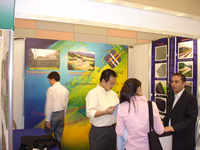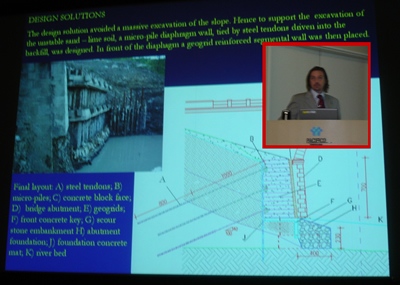 |
Monday, September 18, 3:30 pm (Standard Time Zone: GMT/UTC + 09:00 hour)
After a day of rest and recuperation geosynthetica is ready to report back for you, in real time, the happenings of our industry’s major event. The 8ICG in Yokohama, Japan is underway. Running from September 18 to 22, 2006, the conference started with Training Courses this morning and will end with the Terzhaghi Lecture, Geosynthetics Engineering: Successes, Failures and the Lessons Learned, authored by J. P. Giroud and the Rankine Lecture, Long Term Performance of Containment Barrier Systems, authored by R. Kerry Rowe.
 |
|
Technical Training Courses included: – Geosynthetics Types and Functions (E. Palmeira) |
So far, the exhibitors are commencing with the set-up of their booths. Several of geosynthetica.net’s Underwriters are creating their spaces for tomorrow’s official Exhibition opening.
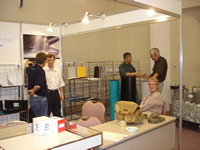 |
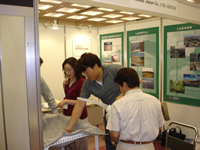 |
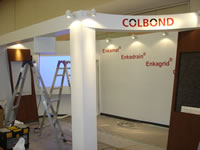 |
|
Paul Barker and the Agru crew |
CETCO preparing a display | Colbond’s booth getting underway |
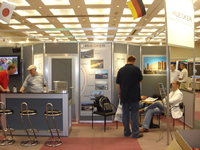 |
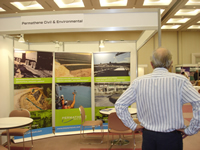 |
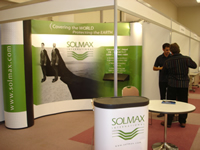 |
| Huesker’s booth will welcome the exhibition visitors at the door | Permathene at the ready | Solmax under construction |
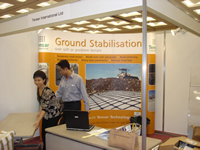 |
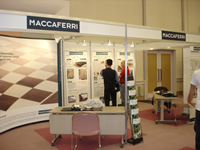 |
|
| Tensar International | Maccaferri | geosynthetica’s newest Underwriter, ACE Geosynthetics |
Tuesday, September 19, 6:00 am (Standard Time Zone: GMT/UTC + 09:00 hour)
Last night saw a standing room only crowd listening to J.P. Giroud give the Terzaghi Lecture and R. Kerry Rowe the Rankine Lecture. For all the conference proceedings abstracts, please click the following link: conference proceedings abstracts.
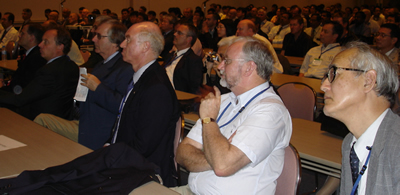 |
| Wim Voskamp, Daniele Cazzuffi, Barry Christopher, John Cowland, Mike Sadlier, and future IGS President Fumio Tatsuoka |
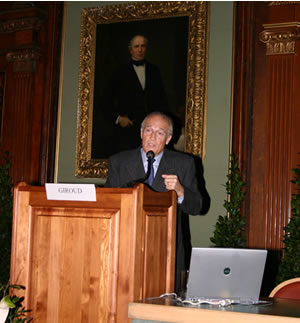 |
 |
| J.P. Giroud presents the Terzaghi Lecture | R. Kerry Rowe receives a plaque from Fumio Tatsuoka after giving the Rankine Lecture |
Post-lecture, old friends caught up with each other in the lobby, reminiscing about old projects and discussing new ones.
 |
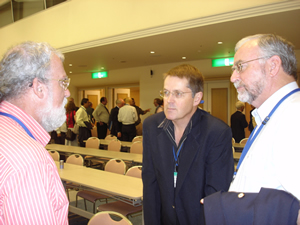 |
| Giroud speaks with fellow French attendees | Ian Peggs, Du Toit Viljoen, and Mike Sadlier |
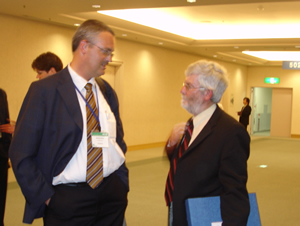 |
| Gerhardt Brau and R. Kerry Rowe |
Afterwards, IGS members crossed over to the Harbor Lounge for the IGS Corporate Members Reception.
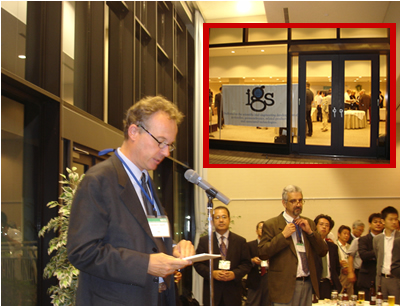 |
| IGS President Daniele Cazzuffi welcomes all |
A warm welcome was given by the out-going President, Daniele Cazzuffi, with special thanks to a very high number of IGS Chapter Presidents and Vice Presidents in attendance.
Tuesday, September 19, 2:45 pm (Standard Time Zone: GMT/UTC + 09:00 hour)
Nobuo Kiyokawa, Conference Secretary, chaired the Opening Session on Tuesday morning in the Main Hall.
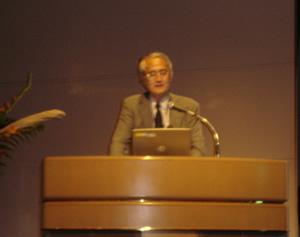 |
| Future IGS President and Conference Chairperson, Fumio Tatsuoka |
He introduced Conference Chairperson and future President of the IGS, Fumio Tatsuoka, who welcomed all the attendees (as of today, over 800 have registered). He continued his address by listing a number of IGS conference firsts:
- The largest number of technical papers (350) was accepted in the history of the ICG for the last nearly 30 years.
- The largest number of papers will be orally presented so that as many as participants, in particular, younger colleagues, can have a chance to report results from his or her technical and research activities and the participants can hear them.
- The largest number of case history papers was accepted. In particular, as the first time in the history of the IGC, nearly 100 very interesting and useful case history papers were submitted from a number of IGS chapters.
- A special lecture on the history of the IGS will be made, which is now very useful and interesting for the IGS colleagues, in particular young colleagues, to understand the spirit and the uniqueness of the IGS.
- A practitioners and academics forum will be held for the first time in the history of the ICG.
Tatsuoka turned the mike over to Pedro Sêco e Pinto, President of the ISSMGE (an 8ICG Supporting Organization), who spoke of the role, history, and progress of the International Society of Soil Mechanics and Geotechnical Engineers.
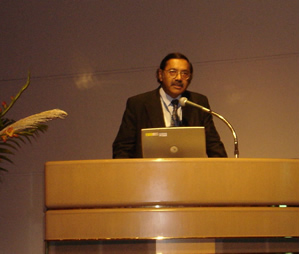 |
| Pedro Sêco e Pinto, President of the ISSMGE |
Daniele Cazzuffi followed and took the traditional step as the President of the IGS of declaring the conference officially open. He graciously thanked all parties responsible for organizing the event and the attendees for participating. Cazzuffi introduced J.P. Giroud to the podium to make a special presentation of the History of the IGS, its foundations, and how the discipline was introduced to the world.
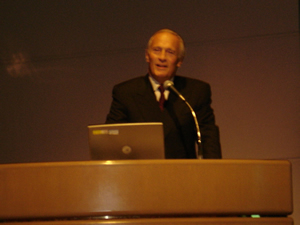 |
| First IGS President, J.P. Giroud |
At the conclusion of his speech, Giroud put forth this challenge to the young members of the IGS:
"It is your challenge to open our discipline to the world…to disseminate information."
Richard Bathurst closed the session by introducing the IGS Pioneers: J.P. Giroud, J.P. Gourc, D. Fayoux, P. Delmas, B. Myles, P. Rankilor, P. Stevenson, C. Fuller, P. Barker, B. Holtz, B. Christopher, G. Heerten, C. Finazzi, D. Cazzuffi, M. Fukuoka, T. Yamanouchi, J. Kassner and C. Lawson.
 |
| IGS Pioneer Paul Barker of Agru accepts his plaque of recognition from past Presidents Colin J.F.P. Jones and Richard Bathurst |
IGS Pioneers fulfill the following criteria:
- Attendance at the Paris Conference (1977) and all subsequent ICG conferences including Yokohama
- Attendance at the Las Vegas Conference (1982), including the ad hoc meeting that initiated the planning and subsequent formation of the IGS and attendance at the next six conferences and planning to be in Yokohama and/or
- Recognized activity and contribution to the IGS and the industry over the period of 1977 to the present and planning
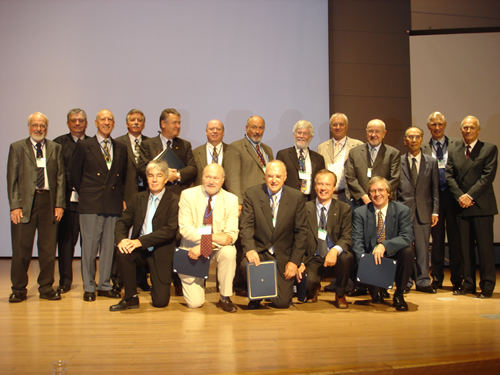 |
| Your IGS Pioneers |
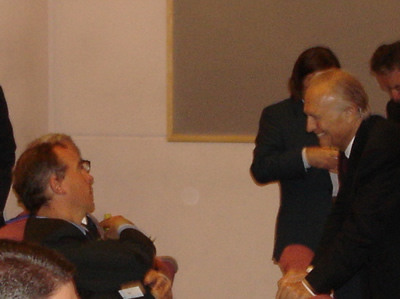 |
| The first IGS President takes a moment with the current and future IGS Presidents |
The Giroud Lecture “Geotextile Containment for Hydraulic and Environmental Engineering” by Chris Lawson was introduced by Hiroshi Miki.
 |
| Chris Lawson presents the Giroud Lecture |
The Exhibit Hall Grand Opening was next on the agenda.
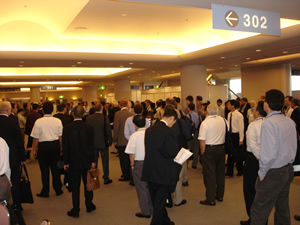 |
| Conference goers gather in the lobby in anticipation of the doors opening to the Exhibition |
The Exhibition in full swing:
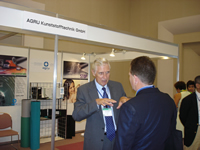 |
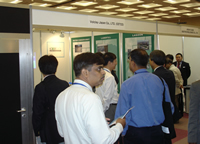 |
 |
| CETCO | Colbond | |
 |
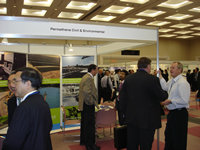 |
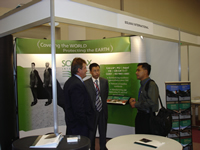 |
| Huesker | Permathene | Solmax |
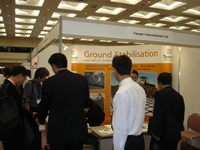 |
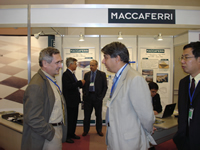 |
|
| Tensar International | Maccaferri | ACE Geosynthetics |
Tuesday, September 19, 10:30 pm (Standard Time Zone: GMT/UTC + 09:00 hour)
After the paper presentations were done for the day, the poster session officially opened and the Ice Breaker reception started.
 |
| The poster session across from the Exhibit Hall |
Later, the masses dispersed for dinner and geosynthetica was lucky enough to run into Peter Legg, President of the South African IGS Chapter (GIGSA), who kindly invited us to eat in Chinatown with several of his fellow South Africans. A good time was had by all.
 |
| Yokohama’s famous Chinatown |
Wednesday, September 20, 12:45 pm (Standard Time Zone: GMT/UTC + 09:00 hour)
geosynthetica.net started the day bright and early at breakfast with the gentlemen from Permathene. We discussed the state of erosion and stormwater control and the needs of geosynthetic designers and engineers in Australia. Thanks for the great company guys!
Officially speaking, day two of the conference started out with the Keynote Lecture, "Seismic Stability of Reinforced Soil Walls" presented by Junichi Koseki. Reviewed were the performance, analysis and design of geosynthetic reinforced soil retaining walls (GRS RWs), the lessons learned, replacement of failed walls with GRS RWs, and new technologies, such as combined soil-cement and geosynthetic reinforced layers and the use of geofoam seismic buffers.
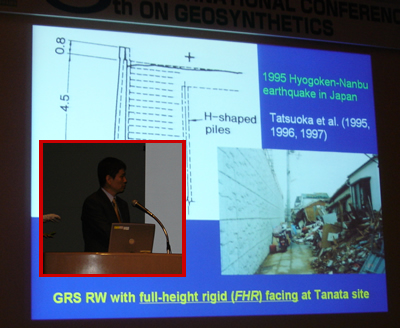 |
| Keynote Lecturer Junichi Koseki, University of Tokyo, Japan |
Next, Pete Sevenson, IGS Secretary, took the podium to introduce the IGS Student Award winners.
 |
| Pete Stevenson introduces the IGS Student Award winners |
The award winners are:
- Eng Carlos V. dos Santos Benjamin (Brazil)
- Zhueng, Yanfeng (China)
- Bastien LeHello (France)
- Florian Bussert (Germany)
- Agatino Simone Lo Grasso (Italy)
- Susumu Nakajima (Japan)
- Sun-Bin Kim (Korea)
- Andrei Mihai Baicu (Romania)
- Tawatchi Tanchaisawat (Thailand)
- Gary Fowmes (UK)
- Karina Lange (NAGS) – unable to attend
 |
| The IGS Student Award winners |
Thursday, September 21, 6:50 am (Standard Time Zone: GMT/UTC + 09:00 hour)
geosynthetica sat in on the first afternoon session in W-4 “Sealing and Drainage of Barriers” in the Main Hall. A few of the speakers are shown below.
 |
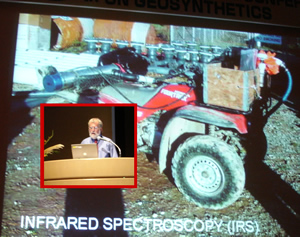 |
| The paper, "Drainage performance of composite geotextiles under confined loads" was presented by Han-Yong Jeon… | …and Ian Peggs of I-CORP INTERNATIONAL presented his paper, "Portable methods of locating leaks in liners and their integration" |
The second afternoon session held in the Small Auditorium was T-4 “Reinforced Wall,” chaired by Dr. Ching-Chuan Huang and Co-Chaired by geosynthetica’s own Christopher Kelsey.
 |
| Huang and Kelsey Chairing the Reinforced Wall Session |
Richard Bathurst presented a very interesting paper that generated lots of questions in the unfortunately limited time allotted. His paper, titled, "Design and Performance of an 11-m High Block-Faced Geogrid Wall," dealt with a wall that "was built with only 65% of the reinforcement currently required by North American design codes."
 |
| Richard Bathurst plotting measured and predicted strains |
The K-Stiffness Method was used and "was shown to give an acceptably accurate prediction of measured reinforcement strains," and that the "performance of the wall has been excellent." Richard went on to report that the K-Stiffness Method requires refinement to "design for elevated connection loads."
| 8ICG Session Report – Christopher Kelsey, Session Co-Chair, reporting:
Reinforced Walls Chair: Dr. Ching-Chuan Huang, Taiwan, Co-Chair: Mr. Christopher Kelsey, geosynthetica.net, Secretary: Dr. Yoshida Teru, Japan Despite missing a few invited presenters, the 8ICG “Reinforced Walls” session on the afternoon of 19 September treated attendees to a wide-ranging, satisfying discussion. The presenters took the audience into the lab and into the field. Papers analyzed the soils beneath and behind walls. The presenters discussed design, installation, general practice and future research needs. New walls were discussed
The five papers delivered in the session and their presenters were:
Prof. Huang opened with a five-minute introduction that prepared the audience for the key points in the session. Afterwards, he allowed each presenter 10 minutes plus 3 minutes for Q&A with the audience, though the audience was determined to run beyond those 3 minutes per paper. The discussion was engaging. Still, Prof. Huang kept the session on time. With the final paper, the session was allowed to run to the end of time. And with the audience’s permission, Prof. Huang issued his closing remarks at one minute past the session’s posted conclusion, the co-chair read an IGS announcement, and the session was closed. An additional note: the Small Auditorium space at Pacifico Yokohama was comfortable for all, and the staff members who provided audio-visual assistance were more than courteous. Also, Dr. Yoshida’s service as secretary, both before and during the conference, was greatly appreciated. It was, all in all, a well-received, successful session. |
After the sessions, there was another drinks reception where colleagues got together to discuss the day’s events, and the evening’s dinner plans! Several members of the conference took advantage of the harbour cruise and saw the Yokohama Bay from the water. Upon disembarkng, they were greeted with a 5-piece band playing traditional jazz.
 |
| The Yokohama Bay Cruise |
Thursday, September 21, 3:00 pm (Standard Time Zone: GMT/UTC + 09:00 hour)
Michael Heibaum started day three of the conference with the 2nd Keynote Lecture, "Hydraulic Applications of Geosynthetics," a very well-rounded and complete profile. Upon the lecture’s end, Chairperson Toshinobu Akagi remarked that he had done a paper "on this very subject nearly twelve years ago" and he was very pleased to see how far the technology had come. Also, he was envious of all the assistance that Heibaum had had with his impressive array of distinguished co-authors! Akagi said he wished he’d had that kind of help back then! He then further congratulated Heibaum with a gift of appreciation.
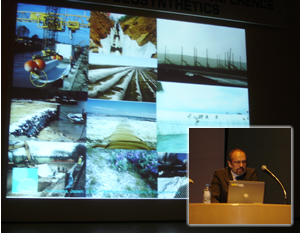 |
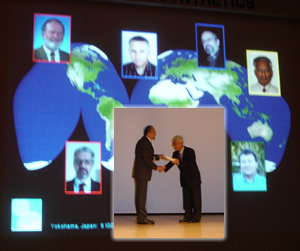 |
| Michael Heibaum presents the 2nd Keynote Lecture | Akagi presents Heibaum with a gift, in the background slide are pictures of his co-authors |
geosynthetica then went to sit in on the morning session R-12 “Durability of Geosynthetics (Chemicals, Damages, Etc), Chaired by Colin J.F.P. Jones, and Co-Chaired by Eun Chul Shin, replacing You Seong Kim. Some presenters are pictured below:
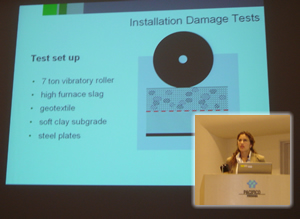 |
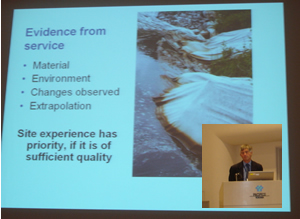 |
| Mahnaz Paloma Nikbakht presented, "National European Specifications and the Energy Concept." She concluded by stating that "energy is an important property to specify damage resistance," but "a uniform definition must be found." | John Greenwood presented, "How to Predict Hundred Year Lifetimes for Geosynthetics," which he referred to as a 2-day course condensed into 8 minutes! |
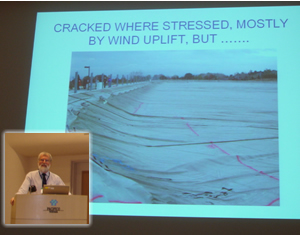 |
| Ian Peggs of I-CORP INTERNATIONAL presents his second paper of the conference, "Investigation of Stress Cracking in a Reinforced Polypropylene Floating Cover" |
Wrapping up the session, Chairperson Colin Jones gave his thanks to all the presenters for the wonderful job on what he said was a very difficult and complex subject, and that he was "fascinated by the quality of work going on in this area."
Friday, September 22, 6:30 am (Standard Time Zone: GMT/UTC + 09:00 hour)
Shobha Bhatia’s very informative presentation was of note in the afternoon session, E-1 Erosion Control – Slopes. The paper, The Use of Index and Bench-Scale Tests for the Characterization of RECPs, considers "the light penetration and water absorption tests developed by TRI and evaluates their usefulness in characterizing and comparing different RECPs." This preliminary work, where more research is anticipated, generated much discussion between Shobha and the session attendees. Shobha commented that many of the questions asked were "excellent ones."
The Special Session, "Practitioners and Academics Forum" followed the afternoon coffee break.
 |
| From the left: Practitioners – Pierpaolo Fantini, John Cowland, Steve Corbet, Georg Heerten, and Barry Christopher Academics – Abdelmalek Bouazza, Ennio Palmeira, Takeshi Katsumi, Chunksik Yoo, Richard Bathurst (Session Chair), and Junichi Koseki. |
This Practitioners and Academics forum was held for the first time in the history of the ICG. Taken from the Message from the Chairman, Fumio Tatsuoka, in the 8ICG Final Program: "It is true that these two groups tend to go in different directions losing effective interactions, despite that this is the key and essence for the development of the IGS."
To an important member of the audience, it seemed that these two groups did lose an opportunity for effective interaction. He said, "I am so frustrated. They were just stroking each other." Another audience member, Mike Sadlier, said he was "rather disappointed. I thought it was going to be a little more lively."
The overall audience consensus seemed to be that the debate was too soft and there was certainly not enough time to address enough audience questions or to get to the meat of the matter. There was one exception near the end of the session. Practitioner Barry Christopher posed the direct question to the Academics, "How much time do you spend teaching a student about geosynthetics? How many hours?" After each panelist answered, Academic Malek Bouazza countered the question and asked how much time is spent on geosynthetics education when a new engineer comes to a firm? Barry handed the question over to Steve Corbet who says he spends quite a bit of time with that person – however, he admitted that he is an anomaly, because he is in the fortunate position to be able to spend that kind of time. That, and he has a great love for geosynthetics. It came back over to Session Chair, Richard Bathurst, who said simply that if you are expecting an undergraduate degree course for geosynthetics to be set up, "You are dreaming in Technicolor."
Friday, September 22, 4:00 pm (Standard Time Zone: GMT/UTC + 09:00 hour)
The last day of the conference started with the third in the series of Keynote Lectures. Overheard on the way down the escalator to the Main Hall was Richard Bathurst, saying that all of the lectures "have been uniformly excellent." John Beech introduced "Geosynthetic Barriers for Environmental Protection at Landfills," presented by Edward Kavazanjian.
 |
| Keynote Lecturer Edward Kavazanjian |
Covered were Liner Systems and their developments in the recent years (adoption in developing countries, cumulative information on their effectiveness, diffusion control systems, and electrical leak location systems). Cover Liners were also discussed (the increased confidence in GCLs, chemically modified GCLs, encapsulated GCLs, and geomembrane ageing), as well Coastal Landfills.
The last of the Technical Sessions began and the Exhibition enjoyed it’s last few hours. Closing Ceremonies are continuing now and the Banquet at the Osanbashi Hall of the International Passenger Terminal will take place later tonight.
Monday, September 25, 1:45 pm (Standard Time Zone: GMT/UTC – 04:00 hour), back at geosynthetica’s West Palm Beach office
After his touching speech during the IGS General Assembly, Daniele Cazzuffi was recognized for his achievements as the President of the IGS for the past four years. President Elect Tatsuoka asked Pete Stevenson to present Daniele with a commemorative signed banner and asked Daniele’s wife, Suzanna, along with their three children, to come to the stage to accept a beautiful bracelet and necklace.
 |
| The Cazzuffi family accepts recognition from the IGS |
During his Secretary’s Report, Pete Stevenson emphasized how the electronic age has helped with the progression of the IGS. Significant stress was placed on its role in the society reaching most of Cazzuffi’s IGS goals (making the organization more interactive; encouraging global expansion; increasing the society’s profile with other engineering disciplines, etc.). Pete and Daniele stressed the need to utilize the Web site down the line as a tool to keep society costs down, expand membership, and all in all provide greater economic parity for the members. The outgoing treasurer, Wim Voskamp of Colbond, noted on one of his slides that $45 US is not worth the same everywhere. He proposed holding the membership dues where they are for the next four years but noted that other expenses might need to be better managed. The Web site remains crucial to this.
And all of this circled back to points JP Giroud made in his speech on the first morning. The "pioneers" of this industry – many of whom were honored that morning – did what they’d intended to do: create a society, develop opportunities for its members, and show how the discipline had permeated all other significant civil engineering disciplines. The newer practioners were now responsible for carrying the message farther, replenishing the membership, and ensuring that the technology continues to be transferred responsibly.
This problem of membership closed the General Assembly meeting as Peter Rankilor, one of the GeoPioneers, stood up and said that he found it worrisome that corporate membership and chapters were growing while individual membership had not. Again, the Web site was touted as a pathfinder, with the propsition of creating a "members only" section to encourage membership.
Tatsuoka made his closing remarks and invited all to the Banquet at the Osanbashi Hall on the 2nd floor of the Osanbashi Yokohama International Passenger Terminal.
 |
 |
| The bay view from the top of the Osanbashi Yokohama International Passenger Terminal | Inside the Hall the attendees were flanked by amazing food |
 |
| The evening began with the breaking of the ceremonial Sake Drum |
The food, beer, sake and entertainment (Taiko Drum performances by two separate groups, one complete with a two-man lion) were all outstanding.
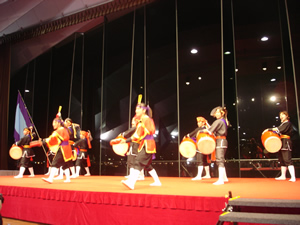
|
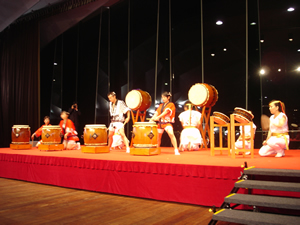 |
| Taiko drummers… | And a second group |
It was a happy close to the week-long conference.
Conference Proceedings Abstracts
